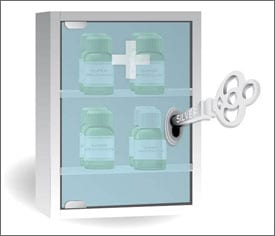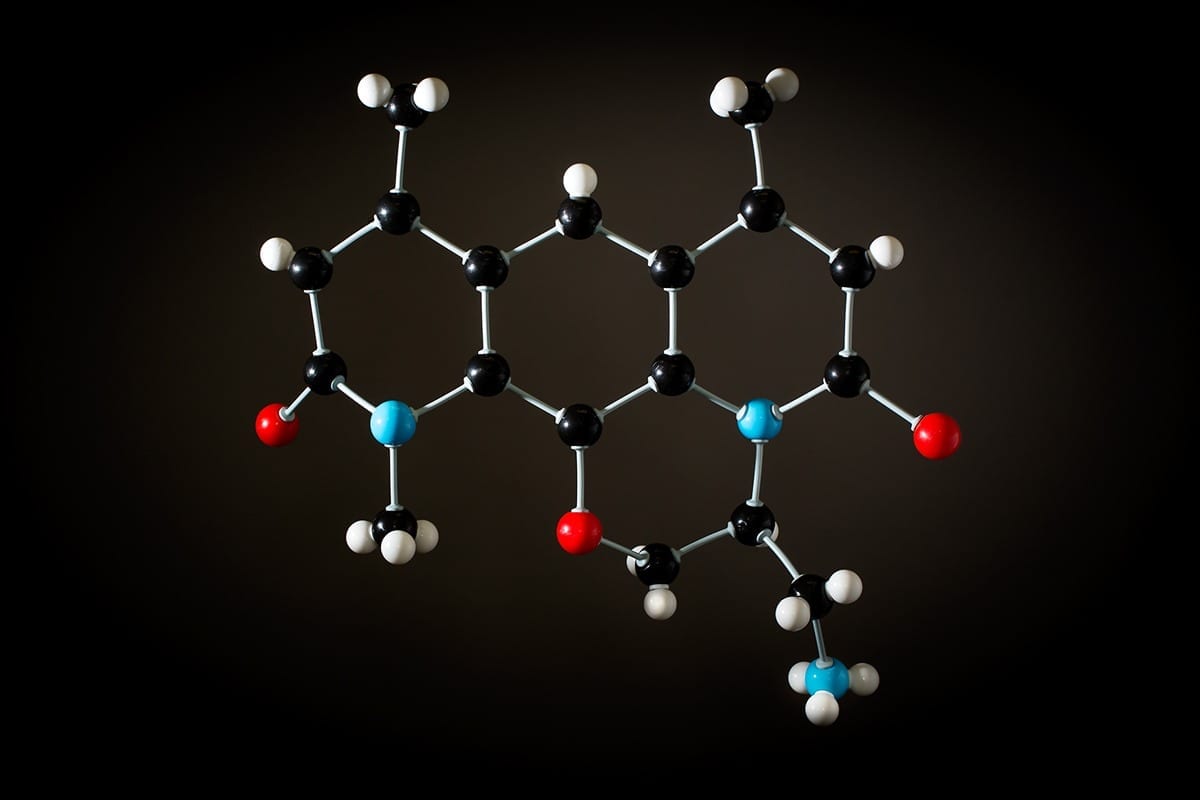
Low doses of silver make bacteria more susceptible to antibiotic attack, paving the way for new therapies for drug-resistant and recurrent infections
Slipping bacteria some silver could give old antibiotics new life, scientists at the Wyss Institute for Biologically Inspired Engineering at Harvard University reported June 19 in Science Translational Medicine.
Treating bacteria with a silver-containing compound boosted the efficacy of a broad range of widely used antibiotics and helped them stop otherwise lethal infections in mice. It helped make an antibiotic-resistant strain of bacteria sensitive to antibiotics again. And it expanded the power of an antibiotic called vancomycin that is usually only effective in killing pathogens called Gram-positive bacteria, such as Staph and Strep. Silver allowed vancomycin for the first time to penetrate and kill Gram-negative bacteria, a group that includes microbes that can cause food poisoning and dangerous hospital-acquired infections.
Silver also proved useful for two types of stubborn infections that usually require repeated rounds of antibiotic treatment and multiple visits to the clinic: dormant bacteria that lie low during antibiotic treatment and rebound to cause recurrent infections, and microbial slime layers called biofilms that coat catheters and prosthetic joints.
“The results suggest that silver could be incredibly valuable as an adjunct to existing antibiotic treatments,” said Jim Collins, Ph.D., a pioneer of synthetic biology and Core Faculty member at the Wyss Institute, who is also the William F. Warren Distinguished Professor at Boston University, where he leads the Center of Synthetic Biology.
In recent years more disease-causing bacteria have grown resistant to common antibiotics, with serious public health consequences. Yet drug companies have struggled for years to develop new types of antibiotics that target these tough bacteria. That has led scientists to re-examine older methods that were used to fight infection well before penicillin use took off in the 1940s. Silver treatment, which has been used since antiquity to prevent and heal infections, is one of them.
Despite silver’s long history of use in the clinic, no one understood fully how it killed bacteria.To find out, Ruben Morones-Ramirez, Ph.D., a postdoctoral fellow at the Wyss Institute who left recently to become a professor at Universidad Autònoma de Nuevo Leon in Mexico, treated normal and mutant strains of E. coli bacteria with a silver compound. Then he observed them under the electron microscope and ran a series of biochemical tests.
He found that silver compounds cause bacteria to produce more reactive oxygen species – chemically reactive molecules that damage the bacterial cell’s DNA and enzymes, as well as the membrane that encloses the cell. Silver also made the bacteria’s cell membrane leakier.
Although silver was used alone as a therapy in the past, the scientists suspected that both changes might make cells more vulnerable to conventional antibiotics — and they did. A small amount of silver made E. coli bacteria between 10 and 1000 times more sensitive to three commonly used antibiotics: gentamycin, ofloxacin, and ampicillin.
“If you know the mechanism, you can have much more success making combinatorial therapies,” Morones-Ramirez said.
In mice, silver also helped antibiotics fight E. coli-induced urinary-tract infections. It made a previously impervious strain of E. coli sensitive to the antibiotic tetracycline. And it allowed vancomycin to save the lives of 90 percent of mice with life-threatening cases of peritonitis — inflammation caused by infections of the abdominal space surrounding the internal organs. Without silver, only 10 percent of the mice survived.
The scientists also did a series of toxicity studies, showing that the doses of silver needed to help antibiotics kill bacteria were far below what could harm the mice. Nor did they harm cultured human cells, suggesting that oral and injectable silver could be safe for humans as well.
The Latest Bing News on:
Drug-resistant and recurrent infections
- SCYNEXIS Reports First Quarter 2024 Financial Results and Provides Corporate Updateon May 8, 2024 at 3:30 pm
SCY-247’s IND-enabling activities continue to progress, with initiation of Phase I anticipated in the second half of 2024Clinical study reports ...
- Study underscores new strategies to fight drug-resistant bacteriaon May 7, 2024 at 12:41 pm
Several billion years ago, a genetic arms race began between bacteria and their viral killers. This seemingly eternal struggle continues today, with implications for diseases killing tens of thousands ...
- Purdue pharmacy researcher receives $2.4M NIH grant to fight antimicrobial-resistant lung infectionson May 6, 2024 at 7:24 am
WEST LAFAYETTE, Ind. — Qi “Tony” Zhou, a researcher in Purdue University’s College of Pharmacy has received a $2.4 million grant from the National Institutes of Health to fight lung infections that ...
- Use of Colistin in the Treatment of Multiple-Drug-Resistant Gram-Negative Infectionson May 3, 2024 at 5:01 pm
baumannii, and its value was confirmed in early respiratory infections involving MDR P. aeruginosa. Furthermore, patients receiving colistin injections did not show nephrotoxicity. In the light of ...
- Hospital toilets are contaminated with drug resistant 'superbugs'on May 1, 2024 at 9:37 am
New study finds high microbial contamination in UK hospital toilets, highlighting need for better cleaning and design changes.
- The battle against urinary tract infections pt. 2on April 30, 2024 at 4:30 am
The battle against urinary tract infections (UTIs) has raged throughout history, with each era bringing new challenges and triumphs in the fight for effective treatments.
- Pathogens including multi-drug resistant superbugs found on floors, ceilings and door handles of UK hospital toiletson April 29, 2024 at 3:10 pm
Pathogenic bacteria and fungi, including multi-drug resistant "superbugs" have been found on the floors, ceilings, door handles and other surfaces of hospital toilets in the UK, with patient toilets ...
- Carbapenems Sometimes Overused for Drug-Resistant Enterobacterales Infectionson April 28, 2024 at 5:00 pm
Opens in a new tab or window Broad spectrum carbapenems were the most commonly used therapy for targeted treatment of extended-spectrum cephalosporin-resistant (ECR) Enterobacterales infections in ...
- Why Doctors Prescribe Older, Less Effective Antibiotics, When New, Less Toxic Treatments Save Liveson April 25, 2024 at 9:00 pm
According to a recent National Institutes of Health (NIH) report, doctors in the United States are still relying on older, less effective, toxic medicines to fight new, highly drug-resistant bacterial ...
- FDA Approves New Antibiotic Against UTIson April 25, 2024 at 7:40 am
So, it's welcome news that the U.S. Food and Drug Administration on Wednesday approved Pivya (pivmecillinam) to fight bacterial UTIs. "UTIs are a very common condition impacting women and one of the ...
The Latest Google Headlines on:
Drug-resistant and recurrent infections
[google_news title=”” keyword=”drug-resistant and recurrent infections” num_posts=”10″ blurb_length=”0″ show_thumb=”left”]
The Latest Bing News on:
New antibiotics
- A New Oral Antibiotic Is Available to Treat UTIson May 8, 2024 at 9:32 am
The FDA recently approved Pivya for uncomplicated UTIs. Pivya is an oral tablet that clears bacterial infections in the female bladder.
- DeepMind’s new AlphaFold 3 expands to DNA, RNA modelingon May 8, 2024 at 7:59 am
Google DeepMind expands its AlphaFold AI system to model how proteins interact with other cell structures including DNA and RNA.
- Recce Pharmaceuticals Granted New Patent in China for RECCE® Anti-Infectiveson May 8, 2024 at 1:00 am
2 About Recce Pharmaceuticals Ltd Recce Pharmaceuticals Ltd (ASX: RCE, FSE: R9Q) is developing a New Class of Synthetic Anti-Infectives designed to address the urgent global health problems of ...
- New plan to tackle antimicrobial resistance launchedon May 7, 2024 at 9:37 pm
A new plan to tackle antimicrobial resistance (AMR), a global issue that makes infections difficult or impossible to treat, has been launched today.
- A mother's loss launches a global effort to fight antibiotic resistanceon May 7, 2024 at 3:00 am
Diane Shader Smith's daughter, Mallory Smith, died at age 25 after fighting an antibiotic-resistant lung infection for 12 years. A new book of her daughter's diary entries and a website are aimed at ...
- FDA Approves New Antibiotic for Uncomplicated Urinary Tract Infectionson April 30, 2024 at 11:30 pm
The U.S. Food and Drug Administration has approved Pivya (pivmecillinam) tablets for the treatment of female adults with uncomplicated urinary tract infections (UTIs). The approval is for UTIs caused ...
- Swedish-led team discovers potential new class of antibiotics, hope for AMR fighton April 29, 2024 at 11:22 am
A new antibiotic against gram-negative bacteria hasn’t been developed since the 1970s. Now, a European research team led by Swedish scientists has discovered multi-drug-resistant bug-killing compounds ...
- No Antibiotics Needed – Revolutionary Chronic Wound Treatment Could Help Millionson April 28, 2024 at 1:29 am
An international team of scientists has developed a new treatment for chronic wounds that uses ionized gas to activate a wound dressing, without the need for antibiotics. The treatment involves the pl ...
- FDA Approves New Antibiotic for Uncomplicated UTIson April 26, 2024 at 11:54 am
The US Food and Drug Administration has approved pivmecillinam (Pivya) tablets to treat uncomplicated urinary tract infections in women.
- What to Know About Pivya, the New Antibiotic Treatment for UTIson April 26, 2024 at 4:06 am
The Food and Drug Administration recently approved Pivya (pivmecillinam) to treat uncomplicated UTIs in female adults. Clinical trials show that Pivya is effective and side effects are limited.
The Latest Google Headlines on:
New antibiotics
[google_news title=”” keyword=”new antibiotics” num_posts=”10″ blurb_length=”0″ show_thumb=”left”]











